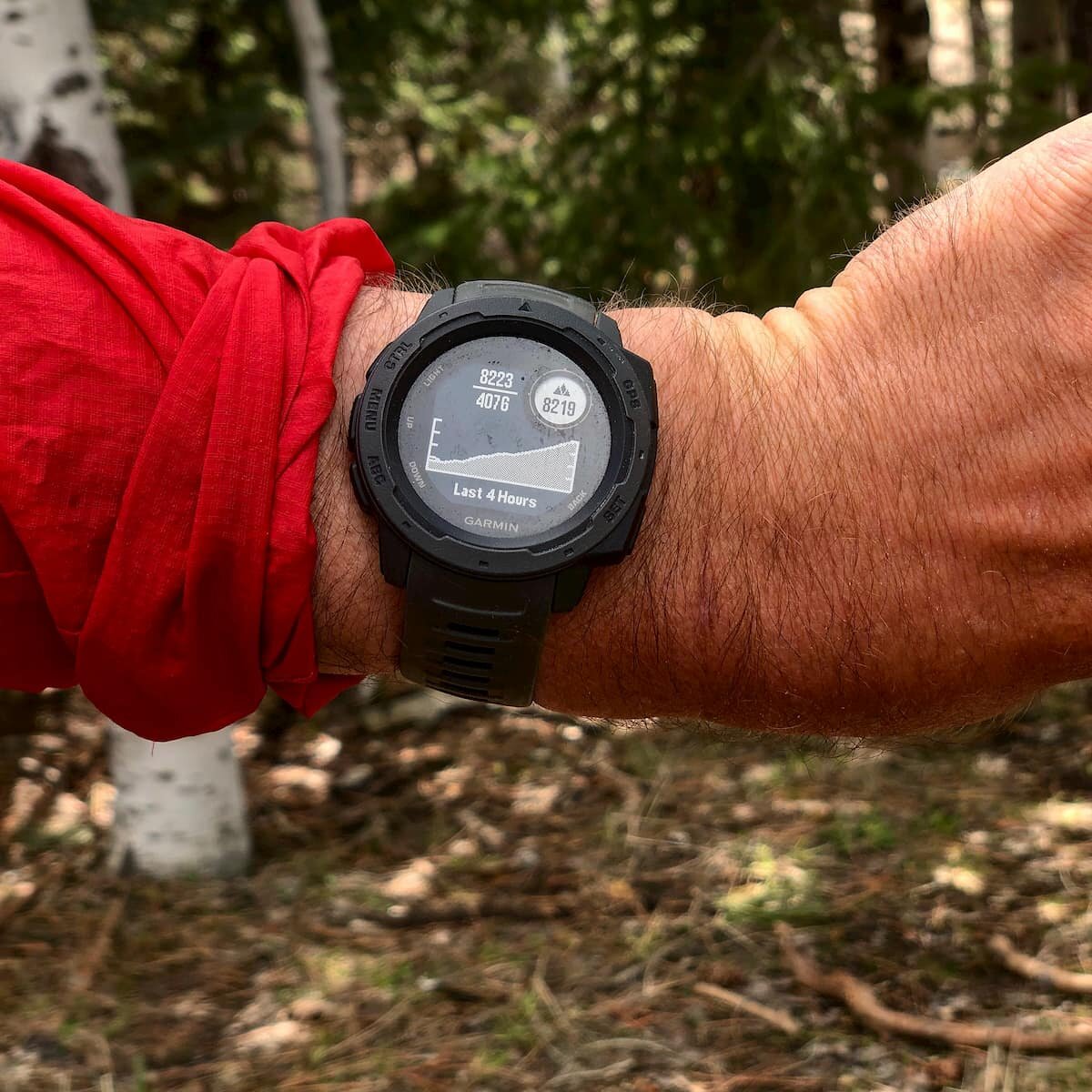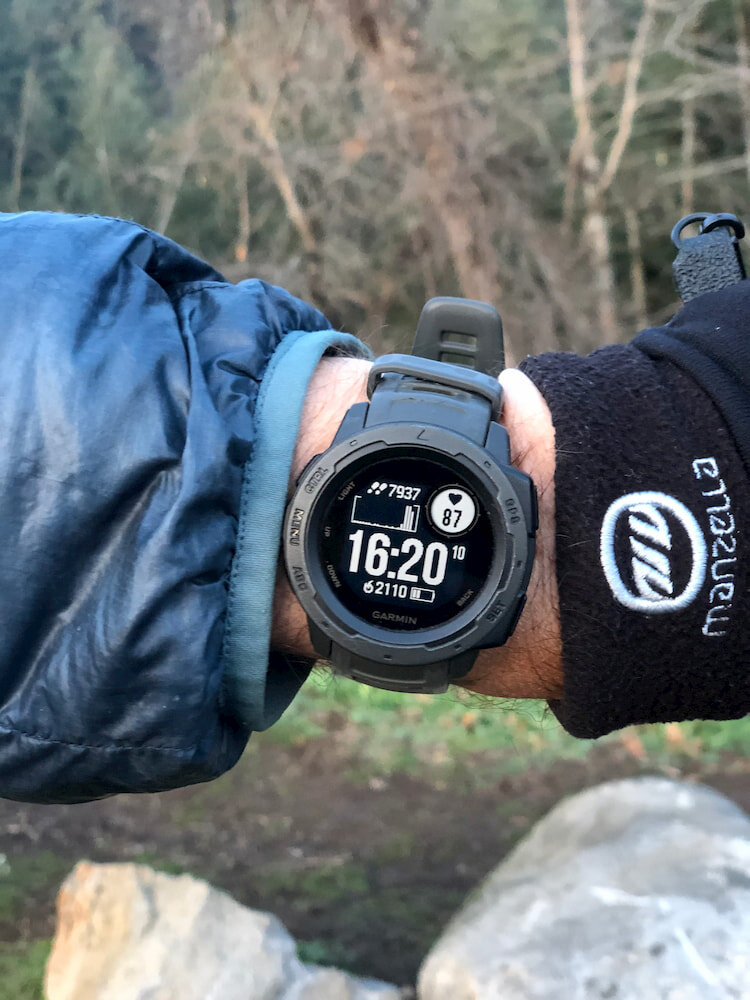Garmin Instinct GPS Watch Long-Term Review
why 8 months and 8 million steps later, we still think the garmin instinct is the best hiking watch
Earlier in 2019, we selected the Garmin Instinct as the winner in our Best Hiking Watch story. We liked that the Instinct is a watch specifically designed for hikers and outdoor adventure enthusiasts: it provides the core ABC (altimeter, barometer, and compass) functions, has GPS navigation, a great battery life, and is very rugged. The Instinct also provides fitness tracking metrics such as heart rate monitoring; step and floor climbing counts; and sleep and stress tracking.
I used the Garmin Instinct on my 2019 thru hikes of the Arizona Trail (800 miles) and Pacific Crest Trail (2,650 miles). Eight months and over 8 million steps later, I continue to believe that the Garmin Instinct is the best hiking watch for most people.
Looking for a newer model? See our long term reviews of the Garmin Instinct 2 and Garmin Instinct 3.
We create reader-supported, objective gear reviews independently selected by our editors. This story may contain affiliate links, which help fund our website. When you click on the links to purchase gear, we may get a commission, without costing you an extra cent. Thank you for supporting our work and mission of outdoor coverage for every body! Learn more.
How I Configured My Garmin Instinct
The Garmin Instinct hiking watch allows for customization within its main screen and specific activity apps. In addition, you can add widgets to provide “ at a glance” information. Available widgets include ABC functions, calendar, calories, compass, steps, floors climbed, heart rate, and many more. I limited the widgets I used to those that were of most interest to me on a thru hike.
Related: The Best Personal Locator Beacons & Satellite Messengers
Main Screen and Widgets
My main screen showed the time of day, step count, heart rate, calories burned, and watch battery level. I find it fun and interesting to track step counts and calories on a long hike. I used the following widgets:
A close-up of the Garmin Instinct watch altimeter widget after climbing out of the north rim of the Grand Canyon on the Arizona Trail.
Altimeter Widget
The altimeter widget shows the current elevation and elevation change over the previous four hours. The Instinct has a barometric altimeter. Therefore, to remain accurate, it is important to calibrate the altimeter several times a day because any change in the barometric pressure will impact the altimeter.
Barometer Widget
The barometer widget shows the current barometric pressure and the change over the previous six hours. You can also set a storm alert if the barometric pressure drops more than a prescribed amount over a three hour period, thus indicating a potential weather change. This is particularly important in areas prone to afternoon thunderstorms, like the Rockies. It also works as a reminder of when to have rain gear handy.
Related: The Best Rain Jackets
Sunrise and Sunset Times
This widget also provides the morning and evening twilight times. I set an alert to warn me 10 minutes before sunset. This told me to either start looking for a campsite or get my headlamp ready for night hiking.
Related: The Best Headlamps
Moon Phase and Moonrise/Set Times Widget
This was interesting and helpful for night hiking.
Compass Widget
The Garmin Instinct has a magnetic compass. We recommend a quality stand-alone compass for map and compass navigation; however, the watch’s compass is great for determining one’s general direction.
Related: Essential Backpacking Accessories
InReach Remote Widget
I carried a Garmin inReach Mini, a two-way satellite communicator, which is our recommended satellite messenger for most people. I connected my Instinct to my inReach device to show incoming messages, similar to how an Apple Watch can show incoming emails or texts. I could also initiate an SOS from the watch; fortunately, I never needed to send an SOS.
Related: The Best Personal Locator Beacons and Satellite Messengers
Music and Podcast Control Widget
The Garmin widget shows the current track playing and allows you to forward or reverse tracks, pause, and adjust the volume. This reduced my need to pull my phone out as I hiked.
Related: The Best Wireless Earbuds for Exercise and Outdoors
Hiking Activity Settings
The Garmin Instinct has built-in activities apps for hiking, biking, walking, swimming, and many more. In addition, you are able to create custom apps for activities not included. I used the hiking activity app for the Arizona Trail and Pacific Crest Trail and customized data fields within the app in order to see the data I found most interesting.
Related: Arizona Trail Gear List
GPS Mode
I usually turned the GPS off in order to save battery. The watch has 14 hours of battery with the GPS on; however, I did not want to have to fully charge the watch every night. I tried using the UltraTrac GPS mode (this sends out less frequent GPS pings and extends the battery life to 40 hours). Unfortunately, when I compared the UltraTrac with the mileage indicated on my maps, I found the UltraTrac distance data was no more accurate than not using the GPS. Instead, I relied on step data to measure distance. With the GPS off, the speed and distance measures were not very accurate. But the altimeter, the watch’s most critical function, worked great.
Altitude Data
The altitude screen showed the current elevation as well as the total ascent and descent for the day. The altitude/elevation data is based on barometric pressure. On the PCT, I manually calibrated the altitude several times a day using a known elevation benchmark, such as a mountain top or trail junction.
Speed and Distance
The speed and distance data were most accurate when I had the GPS on. I use the GPS for day hikes. During the Arizona Trail and PCT thru hikes, I often turn the GPS on for days when I arrived in a town and wasn’t concerned about preserving battery life. The watch provides speed and distance data without the GPS using the watch’s step count; however, it wasn’t very accurate. My speed and distance screen showed the current speed, average speed, and distance hiked.
Moving & Stopped Time
I tracked my moving and stopped time each day. It isn’t important data, but I found it interesting.
Temperature
Although the watch has a built-in temperature sensor, unfortunately it is only accurate after the watch has been removed from your wrist for 30 minutes or more. It’s really most useful to figure out the temperature inside the tent after a night of leaving the watch off of your wrist.
Alerts and Alarms
I found the Instinct’s various alerts and alarms very useful on the trail. Below is a list of alerts and alarms I used:
Sunset Alert
I would get an alert 10 minutes before sunset. This would tell me to start looking for a campsite or get the headlamp ready for night hiking.
Eat & Drink Reminder
I set an alert to remind me to eat something every two hours and drink water every hour. The drink reminder was especially useful in cold conditions when I may not feel thirsty despite needing hydration.
Storm Alert
I set a storm alert to warn me if the barometric pressure dropped 2 mb or more in 3 hours.
Mile Complete Alert
I would get a lap alert for every mile completed. The alert included the lap time and cumulative time.
Alarm Clock
I really like the Instinct’s alarm clock. It allows you to set up multiple one-time or recurring daily alarms. The alarm can be set as a tone, vibration, or both. I found the tone and vibration combination to be sufficient to wake me.
Related: Fall Hiking Gear
What I Liked the Most About The Garmin Instinct
As I’ve noted, I think the Garmin Instinct is the best hiking watch for most people. Below are some of the things I particularly like about the watch:
Customizability
The watch’s apps and data fields can be customized to provide the metrics and data of most interest to you. In addition, the Instinct has 22 different widgets available.
I was able to add widgets or change data fields while in the backcountry, far from a computer or wifi connection. The Instinct, unlike the Garmin fenix 7 or 8, does not support third-party apps from the Garmin Connect IQ store. But, with the Instinct’s 12 built-in watch faces, lots of useful widgets, and customizable activity apps, I was satisfied with my ability to personalize the watch to meet my specific needs.
For more, read our Garmin fenix 7 review and Garmin fenix 8 review.
Altimeter
An accurate altimeter is the most important feature of a hiking watch. The Instinct has a barometer altimeter, so your elevation can be tracked even if you are not using GPS. My hiking partner on the Arizona Trail used the Suunto Core. I found the Instinct’s altimeter to be as accurate as the Core’s. However, as with all barometer altimeters, it is important to calibrate the altimeter several times a day.
Battery Life
In 13 years of thru-hiking, the primary reason I never used a GPS hiking watch was concern over battery life. For the last 13 years, I used the Suunto Observer, a basic ABC watch no longer in production.
However, GPS technology has significantly improved in the last few years, and I was very happy with the Garmin Instinct’s battery life. The battery was more than adequate to hike 4-5 days using the hiking activity app with the GPS off. I would typically charge the watch every few days in the backcountry with my backup battery.
Compare models of hiking watches based on battery life in the Best Hiking Watch guide.
After 8 months and 3,500 miles of hard use, the watch still looks new. There are no scratches on the watch face.
Button Controls
The Garmin Instinct uses buttons instead of a touch screen found in many traditional fitness trackers. Fitness watches are designed to be used in the gym, where temperature and weather are controlled. Buttons better suit a true outdoors watch. The buttons were easy to use in wet and cold conditions and with gloves on. The buttons also have a nice tactile feel...you know when the button has been pushed.
Readability
The Instinct has a high contrast monochrome screen that is very readable in all light conditions. I never experienced issues with glare. When hiking before sunrise or after sunset, the watch’s backlight would turn on automatically when I turned my wrist to see the watch face.
Durability
The Garmin Instinct is made with a fiber-reinforced polymer and constructed to meet the MIL-STD-810 standard, a military standard regarding durability for shock and environmental extremes, and has a scratch-resistant screen. After around 3,500 miles of hiking, the screen isn’t scratched and the watch still looks new.
Related: The Best Rugged & Waterproof Cameras
Garmin Connect Activity Data
The Garmin Instinct gains its full functionality when paired with your smartphone via the Garmin Connect app. After I synced the watch with the Garmin Connect app, I would get a summary of the day’s hike included a summary of distance, average moving and overall speed, average and max heart rate, elevation gain/loss, minimum/maximum elevation, and calories burned.
Related: Our Favorite Gear for the PCT
Garmin Customer Service
I had some issues adding the watch to my existing Garmin account, which already had a few devices associated with it (like my inReach). After I updated my iPhone to iOS 13, I also had some syncing issues. As a result, I was on the phone with Garmin Customer Service four or five times.
Without exception, the Customer Service folks I dealt with were knowledgeable and friendly. Garmin kept a log of my previous calls, so the service representative knew my history. I never felt rushed to end the call and all of my issues were resolved.
See the Full Story: The Best Altimeter (ABC) Watches
Gear testing is hard work! Author Mike Unger seen here eating pizza and sitting in a chair at Cottonwood Pass on the PCT.
What I Didn’t Like About the Garmin Instinct
No watch is perfect. I have some minor complaints that were mostly related to using the watch on a long distance thru hike.
LTE Coverage or WiFi is Required to Sync with Garmin Connect
On a thru hike, I often go days between decent cellular data coverage or access to wifi. As a result, I am not able to sync my Instinct to the Garmin Connect app. I wish Garmin would allow the watch to sync the data to the Connect app without the need for wireless data coverage. I had a couple of stretches where I went two weeks or so without being able to sync the watch (like the ~200 miles of the PCT in the Sierra which has no road crossings). As a result, I came close to running out of memory on the watch. Fortunately, Garmin’s Customer Service showed me how to delete old activity logs to free up memory.
Step Counts Aren’t Always Accurate
I use trekking poles when backpacking. I have found that when using trekking poles, especially over rocky terrain, the watch often undercounts my steps. I realize this is a very minor issue. Nonetheless, I wish the step counts could be more accurate when using trekking poles.
Related: The Best Trekking Poles
UltraTrac GPS Mode Did Not Provide Accurate Data
UltraTrac is a GPS mode that extends battery life by recording track points and sensor data less frequently. The battery life for the normal GPS mode is 14 hours versus 40 hours with UltraTrac. I used the UltraTrac GPS mode for the first two weeks on the Arizona Trail. I found distance measured to be off by at least 10% when compared to the distance data shown on my maps, essentially no better than using the step count to measure distance. I eventually decided to turn off the UltraTrac GPS mode.
The Charging Connector is Finicky
The Garmin Instinct, like most Garmin watches, is charged via a port on the back of the watch. I found the charging port connection to be easily dislodged, especially when charging in my tent. This is not a critical flaw, just annoying. I wish Garmin could make the charging connection more secure. Update: third-party manufacturers have fulfilled the need for a more secure charging cable. I highly recommend purchasing one of these from Amazon.
Conclusion
The Garmin Instinct is a great hiking watch, worthy of our top recommendation. It is also a great overall fitness watch. I continue to use the Instinct as my everyday watch: tracking my health metrics (heart rate, sleep, and stress), recording all my fitness activities (walking, cycling, strength training, and stair climbing); and providing my phone notifications.
See the Full Story: The Best Altimeter (ABC) Watches











